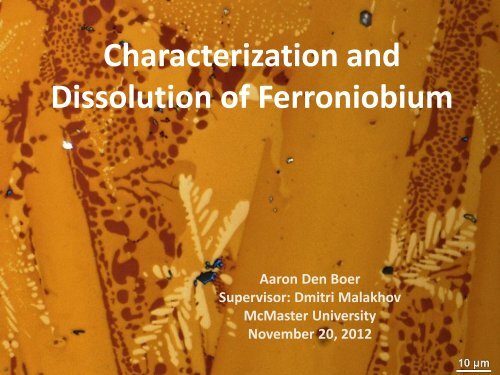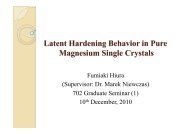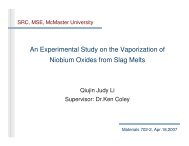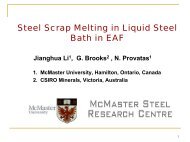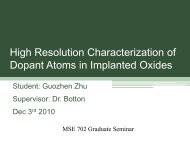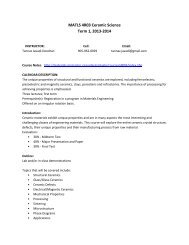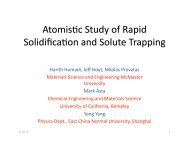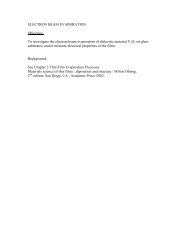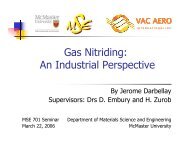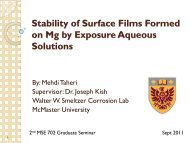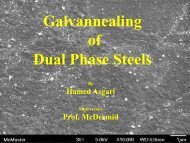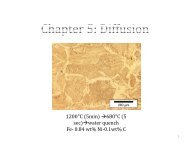Aaron Den Boer - 701 Seminar - November 20 2012 - Course Notes
Aaron Den Boer - 701 Seminar - November 20 2012 - Course Notes
Aaron Den Boer - 701 Seminar - November 20 2012 - Course Notes
Create successful ePaper yourself
Turn your PDF publications into a flip-book with our unique Google optimized e-Paper software.
Characterization and<br />
Dissolution of Ferroniobium<br />
<strong>Aaron</strong> <strong>Den</strong> <strong>Boer</strong><br />
Supervisor: Dmitri Malakhov<br />
McMaster University<br />
<strong>November</strong> <strong>20</strong>, <strong>20</strong>12
Outline<br />
‣ Introduction<br />
‣ Problem Definition<br />
‣ Completed Work – Characterization of FeNb<br />
‣ Current Work – Modelling Solid Nb Dissolution in Liquid Fe<br />
‣ Future Work – Validation of Binary Model<br />
2
Introduction<br />
• Microalloying produces steels (called High Strength Low Alloy<br />
steels) with superior toughness, corrosion resistance, and increased<br />
strength, as compared to some other steels<br />
• Microalloying with elements such as Nb, Ti, and V improve these<br />
properties through grain refinement, and solid solution and<br />
precipitation hardening<br />
3
Introduction<br />
• Evolution of microalloyed HSLA steels has led to the development<br />
of ferroalloy additions in steelmaking<br />
• Microalloying is performed by adding ferroalloys to the liquid steel<br />
during ladle metallurgy FeNb, FeTi, FeV<br />
• One aim of ladle metallurgy is alloying to adjust for target chemical<br />
analysis; the ladle temperature is around 1600°C<br />
• Once these ferroalloys have assimilated into the melt, casting will<br />
result in the formation of fine precipitates at late stages of<br />
solidification<br />
http://www.danieli.com<br />
Porter, Repas, 1982<br />
4
Introduction<br />
• How do these fine precipitates form during solidification<br />
i. “Homogenous” liquid melt<br />
ii.<br />
Phases with high melting<br />
temperatures (i.e. Nb-C,<br />
Ti-N, Ti-C-S) precipitate out<br />
Fe – 0.05 Nb – 0.1 C<br />
(Nb,Ti) (C,N)<br />
Jun, Kang, Park, <strong>20</strong>03<br />
5
Ferroniobium Manufacturing<br />
• A mixture containing alumina, sodium aluminate, iron and niobium<br />
is heated up to 2<strong>20</strong>0°C and held for several minutes<br />
• The melt is completely liquid and cast into a mold or poured on a<br />
flat surface where it solidifies.<br />
• Since freezing of several tonnes of FeNb is characterized by a low<br />
cooling rate, solidification is assumed to proceed according to the<br />
Gulliver-Scheil formalism<br />
• Thermo-Calc can be used to simulate the solidification behaviour<br />
and predict the phase portrait of the Fe-Nb system<br />
Sousa, <strong>20</strong>02<br />
6
Fe–Nb Phase Diagrams<br />
TCFE2<br />
TCFE6<br />
Eutectic<br />
Distectic<br />
C14<br />
µ<br />
C14<br />
µ<br />
http://cst-www.nrl.navy.mil/lattice/index.html<br />
Laves C14 → (Fe,Nb) 2 (Fe,Nb) 1<br />
µ → (Fe,Nb) 7 (Nb) 2 (Fe,Nb) 4<br />
7
Fe–Nb Phase Diagram TCFE2<br />
2<br />
T STEEL<br />
1<br />
BCC<br />
2<br />
µ<br />
1<br />
Voss, Palm, Stein, Raabe, <strong>20</strong>11<br />
8
Problem Definition<br />
• Coarse Nb(C,N) and (Nb,Ti)(C,N) particles were observed on the<br />
fracture surface of bend test specimens<br />
• These coarse particles are detrimental to the mechanical properties<br />
of HSLA steels<br />
• Particle size: >10µm<br />
Abraham, Klein, Bodnar, Dremailova, <strong>20</strong>06<br />
9
Problem Definition<br />
• Abraham et al proposed that the coarse particles were inherited<br />
from multiphase ferroalloys<br />
i. Phases with high melting temperatures are released into melt<br />
via disintegration of ferroalloy<br />
ii. Finite time → non-homogeneous melt<br />
µ Phase<br />
BCC Phase<br />
Abraham, Klein, Bodnar, Dremailova, <strong>20</strong>06<br />
10
Characterization of FeNb + 0.12 wt% C<br />
ICP Analysis<br />
&<br />
Carbon/Sulphur Analysis<br />
Element<br />
wt%<br />
Nb 68.14<br />
Fe 29.38<br />
C 0.12<br />
(Ti, Cu, Al, Mn, P, Si) 2.37<br />
Total 100.00<br />
11
Nb–C Phase Diagram<br />
FCC<br />
HCP<br />
M 2 C carbides, HCP structure<br />
(Nb, Fe,…) 2 (C,N,Va) 1<br />
MC carbides, FCC structure<br />
(Nb, Fe,…) 1 (C, N, Va) 1<br />
12
Characterization of FeNb + 0.12 wt% C<br />
5<br />
1<br />
2<br />
4<br />
3<br />
Location<br />
Elements (at%)<br />
Predicted<br />
Fe Nb Ti Al Si Mn Phase<br />
1 7.60 91.92 0.48 0.00 0.00 0.00 BCC<br />
2 40.93 52.91 0.40 0.89 4.45 0.42 µ<br />
3 35.34 62.16 0.89 0.48 0.83 0.31 η<br />
4 1.92 96.94 1.14 0.00 0.00 0.00 HCP<br />
5 11.09 13.94 0.94 72.94 0.92 0.18 Al<strong>20</strong>3<br />
FeNb + 0.12 wt% C<br />
Phase Image Analysis TCFE2 EBSD<br />
HCP (Red) 2.10 1.83 3.21<br />
BCC (Yellow) 14.70 24.10 9.19<br />
µ 80.80 73.85 87.6<br />
Total 97.60 99.78 100<br />
13
1600°C Isothermals for Fe–Nb–C<br />
TCFE2<br />
TCFE6<br />
Nb C + L<br />
2<br />
Nb C + L<br />
2<br />
NbC + L<br />
NbC + L<br />
14
Characterization of FeNb + 0.7 wt% C<br />
4<br />
3<br />
2<br />
1<br />
6<br />
5<br />
FeNb + 0.7 wt% C<br />
Phase Image Analysis TCFE2<br />
HCP 12.10 11.86<br />
BCC 1.60 13.83<br />
µ 78.50 73.13<br />
LAVES 6.73 0.00<br />
Total 98.93 98.82<br />
Location<br />
Elements (at%)<br />
Predicted<br />
Fe Nb Ti Al Si Mn Phase<br />
1 0.89 98.47 0.64 0.00 0.00 0.00 HCP<br />
2 43.00 51.71 0.41 0.88 3.59 0.41 µ<br />
3 52.18 39.63 0.30 0.99 6.43 0.47 Laves<br />
4 7.29 92.<strong>20</strong> 0.51 0.00 0.00 0.00 BCC<br />
5 8.30 86.74 4.40 0.55 0.00 0.00 BCC<br />
6 0.89 98.47 0.64 0.00 0.00 0.00 HCP<br />
15
Modelling a Binary System<br />
• Isothermal mass transfer phenomena governs kinetics of<br />
dissolution – Mass Balance<br />
• Determination of the time to complete dissolution (TCD) of pure<br />
niobium spheres in pure liquid iron<br />
16
Introduction to Model<br />
• To solve total flux equation, one must know the precise<br />
relationships between the total flux, N, and the fluid field quantities<br />
(v, ρ)<br />
N<br />
A J<br />
A vC <br />
A<br />
total flux<br />
diffusive flux<br />
bulk flux<br />
• This mass transfer coefficient, k, is used to incorporate the bulk<br />
flow and diffusive flow into one parameter<br />
• Both stagnant and convective fluid conditions are bundled up into<br />
dimensionless numbers, specifically the Sherwood number (Sh)<br />
• In a stagnant fluid, v = 0 and Sh = 2 Sh = 2 + f(v,ρ)<br />
Sh<br />
kd<br />
<br />
D<br />
k<br />
<br />
2R<br />
D<br />
<br />
k <br />
DSh<br />
2R<br />
<br />
*<br />
C C<br />
*<br />
NA<br />
D kC C<br />
R<br />
<br />
<br />
<br />
17
Results: Stagnant Fluid<br />
<br />
R R DC<br />
C<br />
2 L *<br />
0<br />
<br />
<br />
S<br />
i<br />
<br />
<br />
<br />
t<br />
kA <br />
<br />
<br />
<br />
i * *<br />
s<br />
C<br />
C C C<br />
exp<br />
t<br />
VL<br />
18
It’s more complicated…<br />
• If velocity is non-zero, how can one handle the total flux<br />
formulation<br />
N<br />
A J<br />
A vC <br />
A<br />
total flux<br />
diffusive flux<br />
bulk flux<br />
• Fluid conditions are handled through the Sherwood number for<br />
both natural and forced convection<br />
19
Convective Fluid<br />
• There are two types of convection that must be considered:<br />
1. Natural Convection<br />
o<br />
the dissolving solid will develop concentration gradients near the<br />
interface, forming a density gradient in the liquid<br />
1/4<br />
Sh<strong>20</strong>.59 Grm<br />
Sc<br />
R<br />
final<br />
dt<br />
N 3/4<br />
C<br />
C R <br />
Natural<br />
R<br />
0<br />
RdR<br />
1 2 0<br />
t<br />
final<br />
2. Forced Convection<br />
o A velocity field is applied and fixed externally on a system<br />
Sh<strong>20</strong>.6Re<br />
Sc<br />
1/2 1/3<br />
R<br />
final<br />
dt<br />
F 1/2<br />
C<br />
C R <br />
Forced<br />
R<br />
0<br />
RdR<br />
final<br />
1 2 0<br />
t<br />
<strong>20</strong>
Results: Convective Fluid<br />
21
Future Work<br />
• Modelling ternary dissolution of Nb-C phases in pure liquid Fe<br />
– Range of stoichiometry<br />
– Solubility product and flux balance at interface<br />
Experiments:<br />
• Dissolution of Fe-Nb and Fe-Nb-C to validate the binary and ternary<br />
models<br />
22
Conclusions<br />
• Thermodynamic databases should be used with caution in relation<br />
to ferroalloys<br />
• The poisonous effect of carbon in ferroniobium should not be<br />
marginalized with respect to size and fraction of niobium carbides<br />
• The solution of the dissolution equation for the Fe-Nb system with<br />
different fluid conditions resulted in a noticeable effect on the TCD<br />
and followed a consistent, logical pattern<br />
• Consideration of the Fe-Nb-C system for modelling of dissolution<br />
and experiments<br />
23
The End…<br />
• With gratitude to the following people and groups:<br />
– Dr. Dmitri Malakhov<br />
– Dr. Gord Irons<br />
– Jim Garrett<br />
– John Thomson<br />
– Chris Butcher<br />
– Doug Culley<br />
– Ed McCaffery<br />
– Xiaogang Li<br />
– Fellow graduate students<br />
– SRC<br />
– CCEM<br />
24
Meta-stable phase, η<br />
2<br />
1<br />
Location<br />
Elements (at%)<br />
Predicted<br />
Fe Nb Ti Al Si Mn Phase<br />
1 34.48 62.46 0.77 0.56 1.73 0.00 ETA<br />
2 35.19 61.02 0.67 0.59 2.52 0.00 ETA<br />
<strong>20</strong>02 - THE IRON - NIOBIUM PHASE DIAGRAM AND THE VISCOSITY OF LIQUID - Korchemkina, Shunyaev 25
EBSD of FeNb + 0.7 wt% C<br />
26
FeNb solidified at CBMM<br />
27


